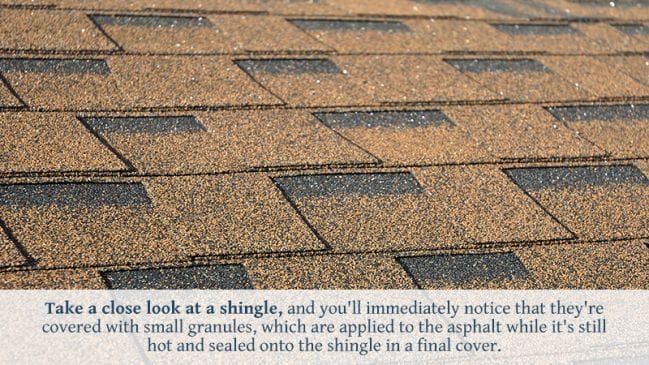Shingles remain one of the most common options for residential rooftops – but what is a shingle, really? What is it made of, and how does it help protect your roof? Let’s take a closer look at all the different parts that make up a shingle, and how they work together to provide great protection at an affordable price.
Fiberglass Mat
Fiberglass is made of thin glass fibers suspended in a plastic resin. The combination makes fiberglass very tough, difficult to break, and highly water resistant – all ideal properties for the core of the shingle. The shingles structure and strength is determined by this fiberglass matting. Since fiberglass is plastic-based, some people prefer a more eco-friendly alternative, which is why there are shingles made with organic-based cores, although they aren’t as durable as the fiberglass versions.
Asphalt
While we usually associate asphalt with roads, asphalt itself is simply a tar-like substance that’s used to bind, seal, and generally protect things. It provides an important extra layer of protection for the shingle, especially when it comes to water protection. Asphalt is especially resistant to even frequent encounters with water. Combining the asphalt with the fiberglass also increases the strength of the shingle, making it less likely to be damaged by debris or hail.
Granules
Take a close look at a shingle, and you’ll immediately notice that they’re covered with small granules, which are applied to the asphalt while it’s still hot and sealed onto the shingle in a final cover. These granules provide more general protection against the elements, but one of their most important jobs is protecting the asphalt from the sun. During the hotter months, sunlight can expose rooftops to UV radiation, which is damaging for all materials but can especially hurt dark asphalt. So a layer of granules – often colored by a ceramic coating – is used. This layer typically determines the final color of the shingle. One of the easiest ways to tell if shingles are wearing out is to check if the granules have started to fall off.
Back Surfacing
Shingles are typically manufactured with back surfacing, too. This is a layer of sand or similar material applied to the back of the shingle. Interestingly, this doesn’t help rooftops as much as other parts. The back surfacing is primarily used to prevent shingles from sticking to each other when they’re being stacked and transported. Otherwise, shingles would get stuck to each other all the time.
Sealant Strips
Certain edges on the shingles are left free of granules to make them stick together better when installing shingles on rooftops. These edges are often covered with a thin polyester strip that’s removed as the shingles are installed. This may also be where manufacturer codes are placed to identify and monitor shingle products.
Of course, there are many different types of shingles in a variety of sizes and shapes, including some with extra features that can add more protection to your roof. To find out what shingles work for you, or what shingles you currently have, Contact us, a reliable roofing company in Atlanta to schedule an estimate with Rosie’s Roofing today.





